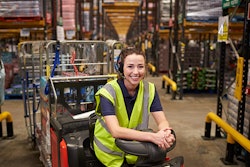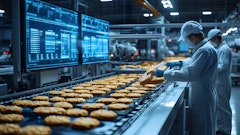
The complexities involved in moving food and beverage products from field to shelf on time and in optimal condition are vast. Emerging trends in the industry, such as changes in consumer demand and preference (fresh produce, ready-made meal kits, etc.), e-commerce, regulatory compliance and a growing labor shortage, have further added to the challenge. In response, food distributors are increasingly turning to voice picking and other wearable technologies to increase efficiency, while reducing the margin for error in distribution operations.
In fact, according to The 2018 MHI Annual Industry Report, the rate of adoption for wearables and mobile technology will grow from 23 percent to 72 percent in the next five years.
While large food and beverage companies were some of the first to utilize voice and wearable technologies to boost productivity, the mid-market has traditionally been slow to adopt new technologies. Today’s growing focus on fresh foods, and in turn food safety, means paper and pencil is no longer a viable option.
Log in to view the full article
The complexities involved in moving food and beverage products from field to shelf on time and in optimal condition are vast. Emerging trends in the industry, such as changes in consumer demand and preference (fresh produce, ready-made meal kits, etc.), e-commerce, regulatory compliance and a growing labor shortage, have further added to the challenge. In response, food distributors are increasingly turning to voice picking and other wearable technologies to increase efficiency, while reducing the margin for error in distribution operations.
In fact, according to The 2018 MHI Annual Industry Report, the rate of adoption for wearables and mobile technology will grow from 23 percent to 72 percent in the next five years.
While large food and beverage companies were some of the first to utilize voice and wearable technologies to boost productivity, the mid-market has traditionally been slow to adopt new technologies. Today’s growing focus on fresh foods, and in turn food safety, means paper and pencil is no longer a viable option.
“A lot of small- to medium-size growers and handlers and processors have looked at technology as a cost rather than a benefit. And that has put them behind in utilizing those technologies,” says Bruce Stubbs, director of supply chain industry market at Honeywell.
But, the industry has now evolved to finally catch up to voice—out of necessity.
“With the focus on fresh and healthier choices, there also comes the safety part of food, and it’s no longer viable to continue to use paper,” says Stubbs. “If there’s a problem with something and I’ve handled everything through paper, it might take days to dig out a file and pinpoint where the problem started and then be able to initiate some type of recall or notification to the end user community about what’s happening. If I’m doing it electronically, it could take minutes.”
Beyond the obvious food safety benefits, efficiency is still central to food and beverage operations. As increased transportation costs and a growing capacity shortage tighten already slim margins, and consumer expectations continue to drive change, Keith Phillips, president and CEO of Voxware, says productivity is still the key to maintaining profitability, especially in today’s environment where the unemployment rate is so low.
“We’re no longer in an environment where you can just add people into the mix to improve or increase the throughput to the warehouse, so it’s almost a necessity that organizations leverage technology,” says Phillips.
Efficiency Still King
Demand for fresh foods has shown no signs of a slowdown anytime soon—and automation of the distribution process will be critical to keeping up.
“There’s a lot of opportunities as well as a necessity to automate those environments,” Phillips says, because, “it’s a very different process than just picking product and shipping it to a restaurant or a store location. There are many more moving parts, and it has to move much more rapidly.”
According to Phillips, among Voxware’s customers that provide products in the fresh space, they’ve seen growth in their distribution operations by 25 percent to 50 percent in the last 18 months. On top of that demand, he adds that today’s society has very little patience for late or inaccurate deliveries.
“If Amazon tells you an order’s going to show up on your doorstep on Thursday morning, you’re standing on the doorstep waiting for it on Thursday morning. That’s just the world that we live in. So it’s all about accuracy and driving the highest level of productivity that you possibly can. And we believe that you do that with multiple technologies, not a single technology,” he says.
Like Voxware, Picavi, which provides a pick-by-vision solution that includes smart glasses, a ring scanner and voice command, believes giving the operator multiple technologies to decide at any time which input option they use is especially important when handling food and beverage products.
“Food and beverage products have different sizes and forms, but the worker has his assisted reality support through the smart glass display, which in some projects even shows him a picture of the product. With the different input options available to him, he can reach smoothly for the relevant barcode—be it fruit, meat, soft drinks or something else and in whatever packaging or transport auxiliary it is stored in the warehouse,” explains Johanna Bellenberg, director of marketing and communications at Picavi.
 Visual guidance can be more relieving for the worker, as the human eye perceives up to 80 percent of its daily sensory
Visual guidance can be more relieving for the worker, as the human eye perceives up to 80 percent of its daily sensory
impressions.Picavi
Voxware combines voice, scanning and augmented reality technologies in a multimodal solution to not only make the picking process more efficient but also to help automate other aspects of the distribution process.
“Leveraging it beyond just the picking area and automating all of the functions that take place in a warehouse, can lead to similar productivity and accuracy increases in any of the functional areas where there’s receiving, put-away, replenishment or cycle-counting, or packing and loading,” Phillips says. “All of those different activities that occur within a warehouse, to the extent that they can be automated, increases the productivity and the throughput of the distribution center.”
Voxware has found that automating other functional areas of the warehouse, not only increases productivity but significantly reduces mistakes.
“Most of the errors that take place in a warehouse are not occurring at the pick-face. The order selectors are going to the right location, they’re picking from the right bin, but the wrong item was put into the bin, either during the put-away process or the replenishment process. So if you automate those processes, then by definition, you’re pick rates are going to go higher as well,” Phillips explains.
According to Honeywell’s Stubbs, many of the efficiencies derived within the DC are simply the result of not recording on pen and paper.
“If I’m handling it with paper, I’m transferring information in a very manual method, and there’s a lot of room for error… which then affects, not just my processes within the DC making them slower, less effective, less accurate, but also introduces error into the chain of custody from end to end of the supply chain in face of a recall.”
For example, when picking product manually, errors can be introduced if a worker transposes a SKU number when writing it, or by the person who receives that information who can introduce an error while manually entering data.
“Doing those things electronically maintains a closed loop, keeping inefficiency and inaccuracy out,” Stubbs adds.
In fact, that electronic chain of custody across the entire supply chain (not just at the warehouse) enhances the whole food logistics process.
“Within the four walls [of a distribution center], they utilize that information in a number of different ways,” Stubbs explains. “Being able to electronically capture that upon receiving [a product] expedites the process, which then makes it easier for [workers] to turn doors and receive more loads. That efficiency is then carried into the storage or the put-away process and replenished out of a location into a pick location and then eventually picked.”
A New Workforce
Voice picking and other wearable technologies are also helping to fill the gaps left behind by a low unemployment rate and shortage of labor. DC work is labor intensive, and it can be hard to attract and retain employees.
In a survey published by the Warehouse Education Research Council, 43 percent of DC executives said that turnover is a major problem, and that low morale is a major cause of it.
Stubbs says giving employees technological tools that not only make their job easier, but more interesting can help attract and then keep those employees.
“It’s not just attracting and retaining, it’s keeping those people. In order to do that, you need to equip them with tool sets that allow them to perform their job. Most people want to do a great job, you just need to get them the tools to do it,” he says.
 Many of the efficiencies derived from wearable technologies within the warehouse are simply the result of not recording on pen and paper.Honeywell
Many of the efficiencies derived from wearable technologies within the warehouse are simply the result of not recording on pen and paper.Honeywell
Wearables also offer the opportunity for companies to utilize morale-boosting programs such as “pay for performance,” which incentivizes employees with benefits like bonuses or extra vacation days.
“It really all ties together; it helps the company, it helps the employee, and it makes the workplace more safe and optimized,” Stubbs notes. “People focus a lot on productivity, and that’s very important obviously, but accuracy is just as important. Now the focus is what DC executives are calling well-being, which includes things like safety, ergonomics, training and retention.
“Picking, especially in the food and beverage industry, is a very hard job,” he adds. “Often, product is heavy and in bulky containers, so we want to be able to apply wearable technologies to enable the user at the distribution center to work in a safe manner and an ergonomic fashion as well. When we’re picking with voice, it’s hands free, eyes up and focused. Voice enables me to use both hands in a safe and ergonomic fashion, so we’re enhancing safety, ergonomics and worker morale.”
In addition, voice picking eliminates the dependency on tribal knowledge, meaning workers do not actually have to be familiar with the warehouse to do their job. This allows companies to onboard and train new employees much quicker.
“You’re not looking at 30 to 45 days to get them ramped up to where they’re as productive as your other workers,” Phillips says, noting that several of Voxware’s customers actually terminate new employees if they are not at full productivity by the end of Day 2.
“From their experience and perspective, they know that if workers are not at full productivity by the end of Day 2, they’re never going to get there,” he adds.
Follow Wunderlin on Twitter.

















